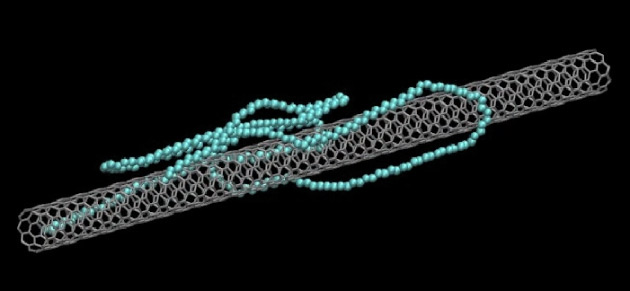RALEIGH, NC – Take some long, skinny molecules that are bunched together like a bowl of spaghetti. Now, try spinning them into a yarn that can conduct electricity. Or perhaps weave them, along with carbon nanotubes, into a next-generation bullet-proof vest.
Sound challenging? It is—but it’s just the kind of challenge Melissa Pasquinelli likes.
Pasquinelli, a textile researcher and assistant professor in the College of Textiles at NC State University, uses computer simulations of polymers—those spaghetti-like molecules—to figure out new ways to take advantage of polymers’ unique properties to make advanced materials.
In 2008, Pasquinelli teamed with RENCI visualization and data software development specialist Sidharth Thakur to develop a suite of visual and analytical tools that could take her polymer simulations to the next level.
“These tools help us connect what’s happening at the molecular level to the macroscopic level a lot easier than I could do with what currently exists,” said Pasquinelli.
The enhanced simulations, she hopes, can help put researchers on the fast-track to developing those super-strong bullet-proof vests and electro-conductive yarns. Scientists in Pasquinelli’s lab and others working on polymer research can use the simulations to try out new approaches—like adjusting temperatures, configurations and processes—virtually, before experimenting with real-life materials.
“Simulations actually can help streamline the process of discovery in the lab,” said Pasquinelli. “These tools that Sid is helping us develop can only streamline that process even more. And they make it a lot more user-friendly for the experimentalist to do exploratory tasks with our simulation data.”
The tools created by RENCI help researchers in Pasquinelli’s lab to extract more information from the models they’ve already developed.
“We take the data from the simulation and build graphical elements and interactive visualizations to help them understand specific phenomena—or to look at aspects of the system as a whole that they can’t observe using other methods,” said Thakur.
The collaboration between Pasquinelli’s lab and RENCI began as an open-ended exploration. Pasquinelli knew that being able to better visualize what’s going on with polymers at the molecular level would help her build more accurate and useful models, but she didn’t know quite what was needed. Thakur worked with her to understand how the simulations operate and to identify where more advanced tools could help.
Quickly the two realized they has embarked on a fruitful collaboration. “Once I realized we could think beyond the visualization and think about the analytic tools, that’s when it clicked,” Pasquinelli said.
“We provide a customized approach to not just visualization, but also analysis of data,” said Thakur. The analytic tools RENCI created allow researchers to use the data from the models in new ways.
In addition, the tools—particularly the visual tools—can help spark new questions and insights about polymer systems. “It’s not just to answer the questions they have but also to explore and pose new questions,” said Thakur. “We categorize it as an ‘exploratory visualization.’”
Now that some of the fundamental tools are in place, researchers from both NC State and RENCI look forward to expanding on what they’ve achieved thus far. “It’s a really nice synergy that we have,” said Pasquinelli.
Thakur presented results from his collaboration with Pasquinelli at a Defense Advanced Research Projects Agency workshop in Washington, D.C. in August.
Links
More RENCI Visualization Projects



